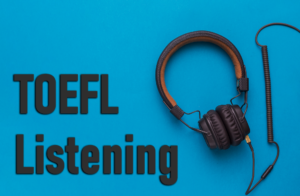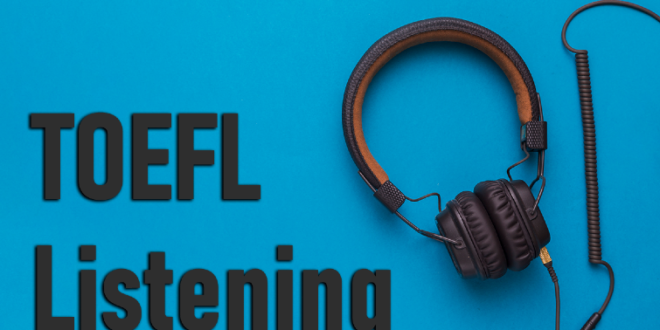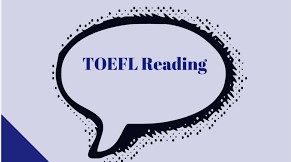
General Structure and Tips for TOEFL Listening Section
The TOEFL iBT is divided into four sections:- Reading, Listening, Speaking, and Writing. The speaking section tests your ability to understand both academic lectures and conversations related to university life. The listening section lasts about 41 minutes. Practice listening and writing at the same time, because the lectures are 3-5 minutes long, and you will not be able to remember all the necessary information.
The conversations will be shorter, but note-taking will still be very helpful. In all you will listen to 3 or 4 lectures 3-5 minutes long about 500-800 words, 6 questions per lecture. 2 or 3 conversations 3 minutes long about 12-25 exchanges, 5 questions each.
Pictures accompanying the speaking segment will let you know if only one or multiple persons will be speaking and also help you imagine the roles and the setting of the speakers. After each listening material is played, you will both see and hear each question before seeing the answer choices.
The Three Question Formats for the TOEFL Listening Section.
- MCQ with four options requiring one correct answer.
- MCQ with four options or more, requiring you order or categorize things.
- You may be required to replay a portion of the question before answering.
Key Features and Tips for the TOEFL Listening Section
First, the recordings, are completely natural with all the “umms,” “likes,” “y’knows,” and sloppy American pronunciation. Second, you can only hear each recording once, and they can be over five minutes long.
Basically, the listening section is difficult because of the amount of information you hear and the expectations of memory. Because of this, take notes and remember a lot of detail!
The lectures can come from any academic discipline that can show up on the reading section—in short, almost anything a freshman could take a class in, except math or mathematical sciences, like physics.
The conversations are either conversations between a student and a professor during office hours, or conversations between a student and some member of support staff/university administration.
Often the second kind of conversation deals with topics like course registration, graduation requirements, and financial aid.
It helps to become familiar with the language and structure of university administration so you don’t get stuck on a listening passage that takes place in a place you’re unfamiliar with, such as, say, a registrar’s office.
Whereas the reading section features very sterile, academic language, the listening section is designed to mimic natural speech. This means that the speakers will pause, change sentences or topics abruptly, and occasionally say something incorrect or forget what they were talking about.
You may be asked questions about these imperfections, so a familiarity with unrehearsed speech is essential to doing well in the listening section. Unlike in the Official Guide, no part of the listening test will ever be transcribed for you.
If a question deals with a particular part of the passage, the test will replay this part for you when you reach the appropriate question. It will not do this for every question, however, so you’ll need to take notes and listen closely.
N/B: Many of the questions on the listening section will look familiar from the reading section, but a few will deal with the unique ability of speech to convey information without words—through intonation and stress, for example.
As you listen to practice excerpts, predict what questions you will be asked. Be aware of the difference in the questions that will be asked for lectures and for conversations.
For instance, general content questions are relatively rare in conversation excerpts, whereas attitude questions are more common in conversations than in lectures.
When learning to listen for specific information, I recommend a three-step approach that combines listening and note-taking (since that’s what you’ll have to do on the test anyway).
First of all, of course, you can’t go back to the recording as you answer the questions. That’s why notes are so important.
Because you can’t go back and listen again, unlike the reading, which allows you to re-read the passage, the listening questions are very fast to answer 10-20 seconds.
Once you’ve submitted an answer, you can’t go back to it as you can on the reading section. You need to answer the questions in order. Never skip any question. Rather, answer every question in the order you see it.
Types of Listening Recordings on the TOEFL
The listening section will expose you to a variety of content both academic and non-academic. Even before the recording starts, your test will give you some idea of what kind of recording you’ll be listening to, which can help you to know what kinds of questions to expect.
Although all listening excerpts are noticeably slower than natural speech, the speakers try to speak as naturally as possible. This means that they use all the “ums,” pauses, and sudden redirects that you would encounter in actual language.
Not only do you need to be able to navigate these incidental cues, but you also need to be ready to comment on how they function in context, as you will probably have to answer at least one question on your test about the meaning of a bite of incidental language.
1. Lectures
The first, and in many ways most grueling, type of listening assignment is the lecture. Generally five minutes, cutting across variety of topics including natural sciences, history, art, anthropology, and business/economics.
Each lecture will begin with a sentence like this: “Listen to the following excerpt from a lecture in an introductory photography class.” There are two basic types of lecture: with students’ questions and without students’ questions.
When there are questions, it may be just one quick interruption or it could be a back-and-forth between the professor and multiple students, in a format similar to a conversation.
In either case, the content is the same: they are completely about some academic topic and are set in a classroom
Every lecture is accompanied by six questions, and they may be of any type. You will usually only see organization questions in lectures so pay extra attention to the organization of any lecture you’re given
2. Conversations
The conversation samples are shorter than the lectures, and they may contain academic or non-academic content. They generally take place either between a student and a professor or between a student and someone in a support role at a university.
Conversations with a professor may include topics like assignment deadlines (non-academic content), clarification of course material (academic content), or upcoming assignments/projects (can be academic or non-academic content).
Conversations with people in support roles include topics like registration, housing, and other logistical aspects of college life. Some familiarity with the language and culture of American higher education will be helpful in understanding the conversations.
Conversations usually last between three and five minutes, and are accompanied by five questions. Conversations are less likely than lectures to have organization or detail questions, but you should expect more questions about attitude and function.
Types of TOEFL Listening Questions
They are usually very similar to those in the reading section. Here’s a quick overview:
1. Purpose Questions
These questions ask you about the purpose of the conversation or lecture, not the content.
These questions will usually begin with “Why”: “Why does the professor explain…” and “Why does the student speak to the professor?” are two possible questions of this type.
The answer to these questions may be inferred, or it may be directly stated by the speaker
2. Specific Detail Questions
These questions will require you to remember particular information. You will need to take notes in order to answer these questions.
Although they seem straightforward, these questions can occur at any difficulty level; a simpler question may ask, “According to the speaker, what is one thing that is true of X?”
A more difficult question may ask you to draw from two or more parts of the recording to determine the correct answer.
3. Function Questions
Function questions are like miniature purpose questions. They will play a word or short phrase from the passage, and you should explain its meaning or usage.
These questions will usually ask “What does ___ mean when he says this?” or “Why does ___ say this?”, followed by a sound bite.
4. Attitude Questions
This is the first question type that isn’t very similar to anything on the reading section.
To answer these, you’ll have to use implied information to decide what the speaker’s thoughts or feelings are at some point in the excerpt.
The information you need may not be linguistic—tone of voice is very important to answering these questions correctly.
5. Organization Questions
These questions ask about how information is arranged and/or prioritized in the excerpt.
6. Connecting Content Questions
Connecting content questions are designed to test your understanding of how ideas in the excerpt are related.
Again, outlining is good preparation for this, as it helps you to reduce a text to the bare minimum, which makes relationships and central ideas more clear.
These may be regular multiple-choice questions, or they may ask you to fill in a chart.
7. Inference Questions
These are very similar to Connecting Content questions; in fact, you could say that inference questions are a subset of questions that can be found in function, connecting content, attitude, and purpose questions.
The key word for this question type will likely be either “infer” or “imply”. In both cases, the information you need will not be directly stated in the passage, which can make this one of the harder question types to answer.
Tips for TOEFL Listening Questions
1. Details Question
Detail questions in the listening section rarely deal with very specific information like numbers or name. Instead, they focus on those facts that you would recognize as important as you listened to the recording.
Do not try to write every single detail. Write the main ideas, the general topics, and listen carefully. Your memory will be enough if you’re paying close attention and understand what the recording said.
2. Attitude question
Attitude questions, like function questions, often deal with information that’s given not just by what the speaker says, but also by how they say it.
They will ask you about the speaker’s attitude–that is, what information the speaker’s intonation and word choice give you about the speaker’s feelings and relationship toward the subject s/he’s discussing.
Attitude questions may also ask you about feelings that are directly stated or strongly implied, as in the following example.
As you practice, you will find that some attitude questions deal with more simple attitudes, as approval or disapproval.
Others, however, may deal with more complex relationships like degree of certainty, irony, excitement, and confusion.
The best way to practice attitude questions is to listen to as much natural speech as you can and pay attention to how intonation and vocal quality change with the speakers’ moods.
For example, in some cases the speaker may imply an attitude of irony or disapproval by exaggerating his or her intonation.
If the speaker speaks haltingly (pauses frequently), s/he may be confused or unsure of what s/he is saying.
We usually show excitement by becoming very animated, a change that will also be noticeable in the sound of the speaker’s voice.
With practice, you will learn to recognize these nonverbal cues and combine them with the words that the speaker uses to understand exactly how the speaker feels.
3. Function Question
Function questions test your understanding of pragmatics, or the implied meaning that we get from context.
They often will ask about a very particular part of the passage, even just a single word.
The question will replay a segment of the recording that contains the topic of the question, and then will replay just the topic.
There will be no transcriptions provided for any part of these questions—all the information will be provided through listening.
Function questions do not deal with the meaning of the words the speaker says, but rather with the information that is implied by how the speaker says them. Let’s take a look at a (partial) list of the general rhetorical functions you may need to be able to identify:-
4. Sarcasm/Irony Questions
Irony occurs when the speaker says the opposite of what s/he means. You can generally tell when something is meant ironically because the literal meaning of the sentence wouldn’t make sense in context.
Sarcasm is a particular kind of irony that is most likely to occur in a conversation.
Usually when speakers are being sarcastic, they will use exaggerated intonation to show this. For example, you may hear someone say “That’s just GREAT,” meaning that whatever they’re talking about is terrible.
5. Redirection Questions
A speaker may use redirection to change the topic or the direction of a conversation.
Professors may use it in lectures to introduce a new point or to get back on track after getting off topic. Common redirect words include “OK,” “so,” and “alright.”
6. Correction/Clarification Questions
Sometimes, professors in a lecture will make a mistake and then have to correct themselves. Any correction is a likely topic for a function question.
A clarification is when the speaker did not make a mistake, but still wants to add more information to make sure the listener understands.
The phrases used to introduce corrections and clarifications are sometimes similar, so watch out for these ones, and use context and intonation to help you decide what the speaker means.
Sentences that contain corrections and clarifications often begin with phrases like “What I meant was…,” “I mean”, “That is,” and “Or rather.”
7. Implied/Indirect Questions and Requests
An implied or indirect question is when the speaker either asks a question, expecting the listener to answer a slightly different question, or makes a statement, expecting the listener to understand that he is actually asking a question and expects an answer.
For example, imagine someone saying “I wonder if you could open the window.” The speaker knows you can open the window, and s/he isn’t actually asking if you can open the window. Instead, he’s asking if you are willing to.
Another example would be a student who tells his professor, “You’re probably too busy to meet with me, aren’t you?” The student is actually requesting that the professor meet with him/her.
8. Rhetorical Questions
A rhetorical question is the opposite of the question we just talked about. It occurs when the speaker asks a question, not expecting an answer. Instead, s/he asks the question in order to make a point.
Think of a parent who, when angry at their teenage child, asks, “Just who do you think you are?” Of course both people know who the child is, but the parent asks this to make the point that the child is acting inappropriately.
TOEFL Listening Question Types and Tips
1. Question Type: Organization
Organization questions occur almost exclusively in lectures and are of three basic types.
The first type will deal with the overall organization of the lecture; the second will ask you about the relationship between two (or more) parts of the lecture; and the third is similar to a function question, but deals with a whole sentence.
If you learn to notice how the information is organized automatically as you listen, then answering overall organization questions will be simple. When the overall organization is in question, these are some of the most likely ways that the lecture may have been organized:-
Likelihood – This type of organization is most often used when the lecture deals with different theories or possibilities. The speaker will begin with the least likely and proceed to the most likely (more rarely, s/he may begin with the most likely and move toward the least likely).
Complexity – The speaker may list the ideas in the lecture from simplest to most complex in order to make the more difficult information more accessible.
Chronology – Lectures in history are often (but not always) organized chronologically—that is, beginning with the first event that occurred and moving up to the one that occurred most recently
Comparison – This scheme of organization groups all the similarities among the items being discussed, then groups all the differences (or the other way around). The professor’s thesis statement, or statement of the main idea of the lecture, will likely give you a clue when a comparative organization is going to be used.
General to Specific – Very often, a lecture will start out with the professor talking about a general concept, and then they will start talking about some more specific details about how that idea works and examples of it in real life.
Cause and Effect – Don’t expect this to be so simple as “A happens, then B happens.” Instead, you might hear about some phenomenon, and then the professor will talk about the three main causes for that phenomenon. Or, conversely, you might hear about one phenomenon and then three different effects it has.
There are others, too, and these structures can also be combined. For example, you might have a comparison structure, but one of the parts in the comparison is more important than others, so it has a general to specific structure within the comparison structure.
This makes it quite tricky, sometimes, to hear the main organization. Keep in mind that the overall organization should include all parts of the lecture: there may be a cause-and-effect relationship that doesn’t relate to the rest of the lecture, for example, and that would not be the main organization.
The second kind of organization question is the one that deals with the relationships between various parts of the lecture. For example, the test may ask you, “How does the professor explain his theory about the causes of the war?”
To answer this question, you would need to look back at your notes and find the information that is relevant to that question. These questions are about the smaller relationships, rather than the overall structure
Finally, we have the function-type organization questions. These will ask you about whole sentences that provide a clue to how the professor is structuring the lecture. For example, the professor will sometimes go off topic, give a personal example to clarify the information, or give information that is redundant.
Often, s/he will announce this by saying something like “You don’t need to write this down” or “Let me show you what I mean.” To answer the third type of organization question correctly, you need to pay attention to these cues.
In particular, pay attention to any time the professor appears to be digressing (going off topic), as you may be asked about the digression later
2. Question Type: Main Idea
Every listening sample will begin in the same way: with a main idea question. These questions ask you to identify the main point of the lecture or conversation.
They usually take one of the following forms:
- Why does the professor ask to see the student?
- What problem does the student have?
- What is the main idea of the lecture?
- What subject is the professor mainly discussing?
When you see this kind of question, remember that you should only be concerned with the main idea of the recording. Supporting ideas, examples, and counterexamples will not be correct answers.
Just because an answer choice is true doesn’t mean that it’s the correct answer. It must be the most important of all the correct answer choices.
But there’s one important exception to make: if the question asks for the main purpose of a conversation (like in the first example given above), that might only be talked about in the beginning of the conversation.
That’s because sometimes conversations change topic, and therefore what was originally the purpose of the conversation changes slightly.
So, for example, a student might go to an administrative office to ask about where they can park their car on campus, but then the conversation might change to the application process for receiving a parking permit.
Now, the purpose of that conversation is for the student to find a place to park their car on campus, although a lot of the dialogue is about an application process.
So for example, suppose the professor says something like “today we’ll be studying the causes of avalanches in the Himalayas, and the look at–uh–the ways these events can devastate Nepalese villages.” The correct answer choice for a main idea/purpose might read “a study of the causes and consequences of a natural disaster in a certain region.”
When answering these questions, consider two things: how did the recording start, and what were the main topics mentioned? The main idea is where those two pieces come together.
3. Question Type: Inference
Inference questions ask you to use context clues and implied information to make educated guesses about the subject matter.
Usually, the question will include a word like “imply” or “infer”, which should be a hint that the speaker will not directly state the answer.
Inference questions will usually look very similar to one of these examples:
- What can be inferred from the Professor’s discussion of X?
- What will the student probably do next?
- What is implied when the speaker says this? (replay a short segment)
Sometimes, the question will replay a sentence from the recording for you; other times, you will need to rely on your notes and memory to answer the question.
Unfortunately, your notes may not always be much help, since you can’t take notes on information that isn’t there.
So when you’re answering inference questions, keep these pointers in mind:-
- Never pick an answer that contradicts a main idea from the passage.
- As you’re listening, pay attention to the speaker’s tone.
- The correct answer will probably use some keywords not found in the recording.
- The implication is very similar to what’s directly said. You do not need to make a large logical jump.
Lastly and most importantly—never draw from your own thoughts or experiences if they’re not also spoken about in the recording.
4. Question Type: Categorization
Categorizing questions ask you to sort key items from the lecture according to certain criteria. Some of the answers will usually be stated, whereas others will be implied, and the categories will usually differ from the most obvious ones mentioned in the lecture.
- Link details to broader topics (similar to the yes/no chart, but with topics instead of “yes” and “no”)
- Put events in order from first to last
- Connect a few key terms to their definitions.
They have slightly different appearances, but you do basically the same thing.
To answer these questions correctly, it helps to have a bit of strategy. Read the chart twice: once to see all of the information, and a second time to fill in the answers.
When you are going through and filling in the answers, start with the ones you’re most confident in. Save the stuff you’re unsure of for last. Doing that makes it easier to stay focused on one piece of information at a time and helps to build a bit of confidence.
Tips for Note Taking in TOEFL Listening Section
Taking good notes is one of the most important skills for success on the TOEFL (and for school) that won’t be directly tested.
- Express Ideas in Few Words
- Use your own words (Even in your own Language)
- Keep moving for whatever is past is past.
- Use symbols such as circle and arrows for cause and effect and down arrow for “Decrease,” “fall,” “short,” “cheap,” or even “worse”
- Only note big ideas and key relationships
- Practice, Practice, Practice!
How to Balance Note Taking and Listening in TOEFL Listening Section
Making your notes an extension of, rather than a distraction from your listening by learning to listen and take notes actively. Finally, as you listen, infer a bit, write often, write what you understand, not what you hear and try to structure.
All the best!
 Healthveli
Healthveli




